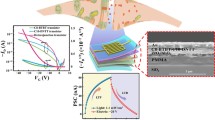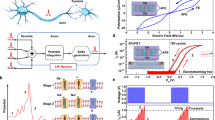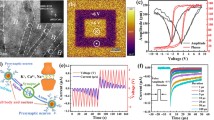Abstract
As Moore’s Law approaches physical limits, traditional von Neumann buildings are facing challenges. The application of memristors in multilayer storage, neuromorphic systems and analog circuits has the potential to overcome the von Neumann architecture bottleneck. Here, we fabricated high-performance memristors based on the Pd/La: HfO2/La2/3Sr1/3MnO3 device on silicon substrate, which facilitate the compatibility with complementary metal oxide semiconductor processes. The memristor devices exhibited good cycling stability and multilevel resistive state storage capabilities. And the synaptic properties of the device, such as long-term potentiation/depression, short-term memory to long-term memory, spike time-dependent plasticity, and double-pulse facilitation, were also shown. Based on the brain-like synaptic behavior of the device, a high recognition rate of 91.11% was achieved in recognizing face images in neural-inspired computing. Through theoretical calculation and hardware associative learning circuit test, the hafnium-based ferroelectric memristor was successfully applied to biological associative learning behavior for the first time.

摘要
随着摩尔定律接近物理极限, 传统的冯诺依曼架构面临挑战. 忆阻器在多层存储、 神经形态系统和模拟电路中的应用具有克服冯诺依曼架构瓶颈的潜力. 在这里, 我们在硅衬底上生长了Pd/La:HfO2(HLO)/La2/3Sr1/3MnO3高性能忆阻器, 其有利于与互补式氧化物半导体工艺兼容. 该忆阻器器件表现出良好的循环稳定性和多级电阻状态存储能力, 以及器件的突触特性, 如长时增强/抑制、 短时记忆到长时记忆、 尖峰时间依赖性可塑性和双脉冲促进. 基于器件的类脑突触行为, 在神经启发计算中识别人脸图像时, 识别率高达91.11%. 通过理论计算和硬件联想学习电路测试, 基于铪基铁电忆阻器的生物联想学习行为得以实现.
Similar content being viewed by others
References
Jo SH, Chang T, Ebong I, et al. Nanoscale memristor device as synapse in neuromorphic systems. Nano Lett, 2010, 10: 1297–1301
Zhai Y, Zhou Y, Yang X, et al. Near infrared neuromorphic computing via upconversion-mediated optogenetics. Nano Energy, 2020, 67: 104262
Kim S, Heo K, Lee S, et al. Ferroelectric polymer-based artificial synapse for neuromorphic computing. Nanoscale Horiz, 2021, 6: 139–147
Fuller EJ, Keene ST, Melianas A, et al. Parallel programming of an ionic floating-gate memory array for scalable neuromorphic computing. Science, 2019, 364: 570–574
Ham S, Kang M, Jang S, et al. One-dimensional organic artificial multi-synapses enabling electronic textile neural network for wearable neuromorphic applications. Sci Adv, 2020, 6: eaba1178
Pan C, Wang CY, Liang SJ, et al. Reconfigurable logic and neuromorphic circuits based on electrically tunable two-dimensional homojunctions. Nat Electron, 2020, 3: 383–390
Chen L, Wang TY, Dai YW, et al. Ultra-low power Hf0.5Zr0.5O2 based ferroelectric tunnel junction synapses for hardware neural network applications Nanoscale, 2018, 10: 15826–15833
Huh W, Lee D, Lee CH. Memristors based on 2D materials as an artificial synapse for neuromorphic electronics. Adv Mater, 2020, 32: 2002092
Burr GW, Shelby RM, Sidler S, et al. Experimental demonstration and tolerancing of a large-scale neural network (165 000 synapses) using phase-change memory as the synaptic weight element. IEEE Trans Electron Devices, 2015, 62: 3498–3507
Pike MD, Bose SK, Mallinson JB, et al. Atomic scale dynamics drive brain-like avalanches in percolating nanostructured networks Nano Lett, 2020, 20: 3935–3942
Yang JQ, Wang R, Wang ZP, et al. Leaky integrate-and-fire neurons based on perovskite memristor for spiking neural networks Nano Energy, 2020, 74: 104828
Wang Z, Joshi S, Savel’ev S, et al. Fully memristive neural networks for pattern classification with unsupervised learning Nat Electron, 2018, 1: 137–145
Kim SJ, Kim SB, Jang HW. Competing memristors for brain-inspired computing iScience, 2021, 24: 101889
Luo Z, Wang Z, Guan Z, et al. High-precision and linear weight updates by subnanosecond pulses in ferroelectric tunnel junction for neuro-inspired computing Nat Commun, 2022, 13: 699
Ding K, Wang J, Zhou Y, et al. Phase-change heterostructure enables ultralow noise and drift for memory operation Science, 2019, 366: 210–215
Yao P, Wu H, Gao B, et al. Face classification using electronic synapses Nat Commun, 2017, 8: 15199
Prezioso M, Merrikh-Bayat F, Hoskins BD, et al. Training and operation of an integrated neuromorphic network based on metal-oxide memristors. Nature, 2015, 521: 61–64
Wen Z, Wu D. Ferroelectric tunnel junctions: Modulations on the potential barrier. Adv Mater, 2019, 32: 1904123
Boyn S, Grollier J, Lecerf G, et al. Learning through ferroelectric domain dynamics in solid-state synapses Nat Commun, 2017, 8: 14736
Moon K, Park S, Jang J, et al. Hardware implementation of associative memory characteristics with analogue-type resistive-switching device Nanotechnology, 2014, 25: 495204
Bichler O, Zhao W, Alibart F, et al. Pavlov’s dog associative learning demonstrated on synaptic-like organic transistors Neural Comput, 2013, 25: 549–566
Nuraje N, Su K. Perovskite ferroelectric nanomaterials. Nanoscale, 2013, 5: 8752–8780
Cheng S, Fan Z, Rao J, et al. Highly controllable and silicon-compatible ferroelectric photovoltaic synapses for neuromorphic computing iScience, 2020, 23: 101874
Max B, Hoffmann M, Mulaosmanovic H, et al. Hafnia-based double-layer ferroelectric tunnel junctions as artificial synapses for neuromorphic computing ACS Appl Electron Mater, 2020, 2: 4023–4033
Mueller S, Mueller J, Singh A, et al. Incipient ferroelectricity in Aldoped HfO2 thin films. Adv Funct Mater, 2012, 22: 2412–2417
Böscke TS, Müller J, Bräuhaus D, et al. Ferroelectricity in hafnium oxide thin films. Appl Phys Lett, 2011, 99: 102903
Müller J, Schröder U, Böscke TS, et al. Ferroelectricity in yttrium-doped hafnium oxide. J Appl Phys, 2011, 110: 114113
Müller J, Böscke T, Müller S, et al. Ferroelectric hafnium oxide: A CMOS-compatible and highly scalable approach to future ferroelectric memories. In: 2013 IEEE International Electron Devices Meeting. Washington, DC, 2013 10.8.1-10.8.4
Batra R, Huan TD, Rossetti Jr. GA, et al. Dopants promoting ferroelectricity in hafnia: Insights from a comprehensive chemical space exploration. Chem Mater, 2017, 29: 9102–9109
Schenk T, Fancher CM, Park MH, et al. On the origin of the large remanent polarization in La:HfO2. Adv Electron Mater, 2019, 5: 1900303
Yu S. Neuro-inspired computing with emerging nonvolatile memorys. Proc IEEE, 2018, 106: 260–285
Chen PY, Peng X, Yu S. NeuroSim: A circuit-level macro model for benchmarking neuro-inspired architectures in online learning. IEEE Trans Comput-Aided Des Integr Circuits Syst, 2018, 37: 3067–3080
Wang YF, Lin YC, Wang IT, et al. Characterization and modeling of nonfilamentary Ta/TaOx/TiO2/Ti analog synaptic device. Sci Rep, 2015, 5: 10150
Kim D, Jeon YR, Ku B, et al. Analog synaptic transistor with Al-doped HfO2 ferroelectric thin film. ACS Appl Mater Interfaces, 2021, 13: 52743–52753
Wang W, Gao S, Li Y, et al. Artificial optoelectronic synapses based on TiNxO2−x/MoS2 heterojunction for neuromorphic computing and visual system. Adv Funct Mater, 2021, 31: 2101201
Ho VM, Lee JA, Martin KC. The cell biology of synaptic plasticity. Science, 2011, 334: 623–628
Kim SJ, Koh HJ, Ren CE, et al. Metallic Ti3C2Tx MXene gas sensors with ultrahigh signal-to-noise ratio. ACS Nano, 2018, 12: 986–993
Strukov DB, Snider GS, Stewart DR, et al. The missing memristor found. Nature, 2008, 453: 80–83
Yu F, Zhu LQ, Xiao H, et al. Restickable oxide neuromorphic transistors with spike-timing-dependent plasticity and pavlovian associative learning activities. Adv Funct Mater, 2018, 28: 1804025
Kim MK, Lee JS. Synergistic improvement of long-term plasticity in photonic synapses using ferroelectric polarization in hafnia-based oxide-semiconductor transistors. Adv Mater, 2020, 32: 1907826
Yang L, Singh M, Shen SW, et al. Transparent and flexible inorganic perovskite photonic artificial synapses with dual-mode operation. Adv Funct Mater, 2020, 31: 2008259
Yan M, Zhu Q, Wang S, et al. Ferroelectric synaptic transistor network for associative memory. Adv Electron Mater, 2021, 7: 2001276
Serrano-Gotarredona T, Masquelier T, Prodromakis T, et al. STDP and STDP variations with memristors for spiking neuromorphic learning systems. Front Neurosci, 2013, 7
Huang W, Fang YW, Yin Y, et al. Solid-state synapse based on magnetoelectrically coupled memristor. ACS Appl Mater Interfaces, 2018, 10: 5649–5656
Wang TY, Meng JL, Li QX, et al. Reconfigurable optoelectronic memristor for in-sensor computing applications. Nano Energy, 2021, 89: 106291
Ge C, Li G, Zhou Q, et al. Gating-induced reversible HXVO2 phase transformations for neuromorphic computing. Nano Energy, 2020, 67: 104268
Hu SG, Liu Y, Liu Z, et al. Synaptic long-term potentiation realized in Pavlov’s dog model based on a NiOx-based memristor. J Appl Phys, 2014, 116: 214502
Ziegler M, Soni R, Patelczyk T, et al. An electronic version of Pavlov’s Dog. Adv Funct Mater, 2012, 22: 2744–2749
Acknowledgements
This work was financially supported by the National Key R&D Plan “Nano Frontier” Key Special Project (2021YFA1200502), the Cultivation Projects of National Major R&D Project (92164109), the National Natural Science Foundation of China (61674050 and 61874158), the Special Project of Strategic Leading Science and Technology of Chinese Academy of Sciences (XDB44000000-7), Hebei Basic Research Special Key Project (F2021201045), the Natural Science Foundation of Hebei Province (F2022201054 and F2021201022), the Advanced Talents Incubation Program of Hebei University (521000981426, 521100221071, and 521000981363), Baoding Science and Technology Plan Project (2172P011), the Support Program for the Top Young Talents of Hebei Province (70280011807), the Supporting Plan for 100 Excellent Innovative Talents in Colleges and Universities of Hebei Province (SLRC2019018), the Outstanding Youth Scientific Research and Innovation Team of Hebei University (605020521001), the Special Support Funds for National High Level Talents (041500120001), the Science and Technology Project of Hebei Education Department (QN2020178 and QN2021026), the Interdisciplinary Key Research Program of Natural Science of Hebei University (DXK202101), the Institute of Life Sciences and Green Development (521100311), and the Post-graduate’s Innovation Fund Project of Hebei University (HBU2022ss021).
Author information
Authors and Affiliations
Contributions
Author contributions Niu J prepared the samples and carried out the measurements. Yan X designed and supervised the experiments. Fang Z conducted the associative learning circuit design and testing. Liu G conducted the face recognition, Zhao Z did the data curation, and Yan X and Niu J wrote the manuscript. All authors contributed to refining the manuscript.
Corresponding author
Ethics declarations
Conflict of interest The authors declare that they have no conflict of interest.
Additional information
Supplementary information Supporting data are available in the online version of the paper.
Jiangzhen Niu received her bachelor’s degree in electrical engineering and automation from the School of Electrical Engineering, North China Electric Power University Science and Technology College in 2019. She is currently an ME student of Hebei University. Her current research focuses on the field of memristors.
Ziliang Fang received a bachelor’s degree from Chuzhou University in 2020. He is a graduate student at the School of Electronic Information Engineering, Hebei University. His current research focuses on the circuit design for memristor applications.
Gongjie Liu received his BS degree from China West Normal University in 2020 and is currently pursuing his MS degree at Hebei University, where his research focuses on memristors and their applications.
Xiaobing Yan is currently a professor at the School of Electronic and Information Engineering, Hebei University. He received his PhD degree from Nanjing University in 2011. From 2014 to 2016, he held the research fellow position at the National University of Singapore. His current research focuses on the field of memristors.
Supplementary Information
40843_2022_2237_MOESM1_ESM.pdf
Multilevel state ferroelectric La:HfO2-based memristors and their implementations in associative learning circuit and face recognition
Rights and permissions
About this article
Cite this article
Niu, J., Fang, Z., Liu, G. et al. Multilevel state ferroelectric La:HfO2-based memristors and their implementations in associative learning circuit and face recognition. Sci. China Mater. 66, 1148–1156 (2023). https://doi.org/10.1007/s40843-022-2237-2
Received:
Accepted:
Published:
Issue Date:
DOI: https://doi.org/10.1007/s40843-022-2237-2




